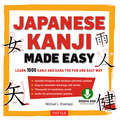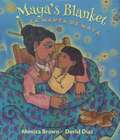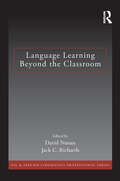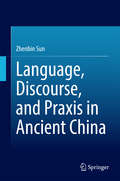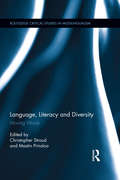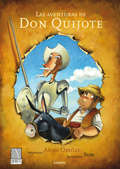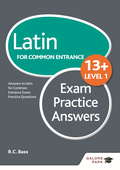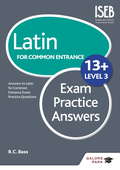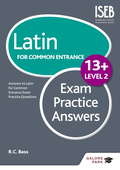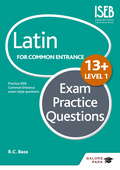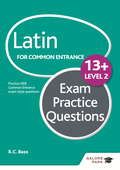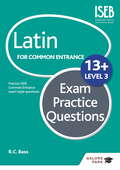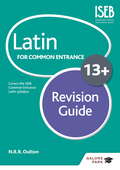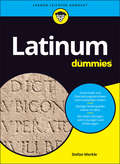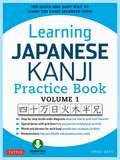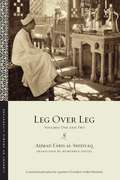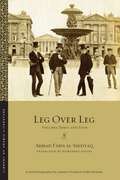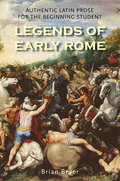- Table View
- List View
Japanese
by Yoko HasegawaThis is an extensive beginning level Japanese textbook and language learning program. Elementary Japanese is designed for students who are just beginning their study of the Japanese language at the first#8211:year college level or on their own. The author and contributors have created a highly structured approach to learning Japanese that is based on learning the fundamental patters and constructions of the language as well as the writing system including basic kanji. Systematic grammatical explanations are provided in enough detail for this book to be used as a referencework as well as an introductory textbook. The accompanying MP3 audio CD is a great way to learn Japanese and ensures correct pronunciation and helps to build listening comprehension. After completing this course, you will be able to: - Describe yourself, your family and your friends. - Talk about daily events using basic vocabulary and grammatical constructions. - Understand conversations on these topics as well as classroom activities. - Read Japanese articles and write short and simple compositions and letters.
Japanese Kanji Made Easy: Learn 1,000 Kanji and Kana the Fun and Easy Way
by Michael L. KluemperMake character memorization a breeze with Japanese Kanji Made Easy! <P><P> Learning the fundamental kanji characters used to write Japanese can be challenging, but this book is designed to speed up learning by presenting the 1,000 most common characters using a mnemonic approach. In a fun and accessible way to learn Japanese, each kanji is associated with memorable visual and verbal clues. For example, the Japanese character for person is superimposed over a sketch of a smiling man. The visual clue is "a person standing on two legs". By seeing the distinctive shape of the kanji, learners create a mental image of its meaning.As well, each character is presented as part of a group of characters which share similar traits. These groups use common root symbols known as radicals; they are also categorized by themes such as colors, numbers, animals, or body parts. Pronunciations, meanings and common vocabulary compounds are provided for each character in the group. Mnemonic clues are also given for the basic 92 hiragana and katakana phonetic symbols. Downloadable audio helps you learn pronunciation for all of the characters and vocabulary in this book. The short introduction explains the basic history and structure of the kanji.Key feature of this Japanese kanji book include: Hiragana and katakana phonetic symbols Easy-to-remember drawings and stories for ALL characters Thousands of vocabulary words Downloadable audio for pronunciation practiceA highly visual book, Japanese Kanji Made Easy is a powerful learning tool for both the serious student of the Japanese language, and those simply curious about kanji.
Language Learning Beyond the Classroom (ESL & Applied Linguistics Professional Series)
by Jack C. Richards David NunanThis volume presents case studies of language learning beyond the classroom. The studies draw on a wide range of contexts, from North and South America to Europe and the Asia-Pacific region. Each provides principled links between theory, research and practice. While out-of-class learning will not replace the classroom, ultimately all successful learners take control of their own learning. This book shows how teachers can help learners bridge the gap between formal instruction and autonomous language learning. Although English is the primary focus of most chapters, there are studies on a range of other languages including Spanish and Japanese.
Language, Discourse, and Praxis in Ancient China
by Zhenbin SunThis book investigates Chinese comprehension and treatment of the relationship between language and reality. The work examines ancient Chinese philosophy through the pair of concepts known as ming-shi. By analyzing the pre-Qin thinkers' discourse on ming and shi, the work explores how Chinese philosophers dealt with issues not only in language but also in ontology, epistemology, ethics, axiology, and logic. Through this discourse analysis, readers are invited to rethink the relationship of language to thought and behavior. The author criticizes and corrects vital misunderstandings of Chinese culture and highlights the anti-dualism and pragmatic character of Chinese thoughts. The rich meaning of the ming-shi pair is displayed by revealing its connection to other philosophical issues. The chapters show how discourse on language and reality shapes a central characteristic of Chinese culture, the practical zhi. They illuminate the interplay of Chinese theories of language and Dao as Chinese wisdom and worldview. Readers who are familiar with pragmatics and postmodernism will recognize the common points in ancient Chinese philosophy and contemporary Western philosophy, as they emerge through these chapters. The work will particularly appeal to scholars of philosophy, philosophy of language, communication studies and linguistics.
Language, Literacy and Diversity: Moving Words (Routledge Critical Studies in Multilingualism)
by Mastin Prinsloo Christopher StroudLanguage, Literacy and Diversity brings together researchers who are leading the innovative and important re-theorization of language and literacy in relation to social mobility, multilingualism and globalization. The volume examines local and global flows of people, language and literacy in relation to social practice; the role (and nature) of boundary maintenance or disruption in global, transnational and translocal contexts; and the lived experiences of individuals on the front lines of global, transnational and translocal processes. The contributors pay attention to the dynamics of multilingualism in located settings and the social and personal management of multilingualism in socially stratified and ethnically plural social settings. Together, they offer ground-breaking research on language practices and documentary practices as regards to access, selection, social mobility and gate-keeping processes in a range of settings across several continents: Africa, Asia, the Americas and Europe.
Language, Literacy, and Technology
by Richard KernFrom the origins of writing to today's computer-mediated communication, material technologies shape how we read and write, how we construe and share knowledge, and ultimately how we understand ourselves in relation to the world. However, communication technologies are themselves designed in particular social and cultural contexts and their use is adapted in creative ways by individuals. In this book, Richard Kern explores how technology matters to language and the ways in which we use it. Kern reveals how material, social and individual resources interact in the design of textual meaning, and how that interaction plays out across contexts of communication, different situations of technological mediation, and different moments in time. Showing how people have adapted visual forms to various media as well as to social needs, this study culminates in five fundamental principles to guide language and literacy education in a period of rapid technological and social change.
Las aventuras de Don Quijote
by Subi Anna ObiolsUna cuidada adaptación para introducir a los más pequeños en la obra de Cervantes Don Quijote de la Mancha Hace muchísimos años, un escritor, Miguel de Cervantes, se inventó una novela, para muchos la mejor de todos los tiempos. Un loco de atar, tierno y entrañable, estaba dispuesto a poner paz en el mundo; para ello contaría con dos ayudas inestimables: su amada Dulcinea y su fiel escudero, Sancho Panza. Con Las aventuras de Don Quijote hemos pretendido acercar a los más pequeños de la casa la genial novela de Cervantes, para que descubran, por primera vez, la ternura y humanidad que se esconde detrás del irrepetible e ingenioso hidalgo Don Quijote de la Mancha.
Latin for Common Entrance 13+ Exam Practice Answers Level 1
by R. C. BassExam Board: ISEBLevel: 13+Subject: LatinFirst Teaching: September 2014First Exam: Autumn 2015This book contains comprehensive answers and a suggested mark scheme to the exercises in Latin for Common Entrance 13+ Exam Practice Questions Level 1- Endorsed by ISEB- Contains both the Latin and English translations to save you time marking work and to help identify areas that require further study- Includes answers for all exercises so that pupils understand how full their responses need to be to achieve top marks
Latin for Common Entrance 13+ Exam Practice Answers Level 1
by Bob BassThis book contains comprehensive answers and a suggested mark scheme to the exercises in Latin for Common Entrance 13+ Exam Practice Questions Level 1. - Endorsed by ISEB- Contains both the Latin and English translations to save you time marking work and to help identify areas that require further study- Includes answers for all exercises so that pupils understand how full their responses need to be to achieve top marks
Latin for Common Entrance 13+ Exam Practice Answers Level 2
by R. C. BassThis book contains comprehensive answers and a suggested mark scheme to the exercises in Latin for Common Entrance 13+ Exam Practice Questions Level 2. - Endorsed by ISEB- Contains both the Latin and English translations to save you time marking work and to help identify areas that require further study- Includes answers for all exercises so that pupils understand how full their responses need to be to achieve top marks
Latin for Common Entrance 13+ Exam Practice Questions Level 1
by R. C. BassThis set of exam-style questions provides pupils with a wealth of practice for 13+ ISEB Latin Common Entrance exams at Level 1. The huge range of questions covers translation, grammar and vocabulary, enabling pupils to familiarise themselves with the types of questions they will face in the real exam. - Endorsed by ISEB- Prepares pupils for Latin Common Entrance and Level 1 entrance exams- Features extensive practice in comprehension and translation both from English to Latin and Latin to English- Includes a complete vocabulary list for Level 1 to serve as a checklist for pupils
Latin for Common Entrance 13+ Exam Practice Questions Level 1 (for the June 2022 exams)
by R. C. BassPlease note, this resource is suitable for the exams up to June 2022. New revision resources will be available from Spring 2022 for the exams from November 2022.Exam Board: ISEBLevel: 13+Subject: LatinFirst Teaching: September 2014First Exam: Autumn 2015This set of exam-style questions provides pupils with a wealth of practice for 13+ ISEB Latin Common Entrance exams at Level 1. The huge range of questions covers translation, grammar and vocabulary, enabling pupils to familiarise themselves with the types of questions they will face in the real exam- Endorsed by ISEB- Prepares pupils for Latin Common Entrance and Level 1 entrance exams- Features extensive practice in comprehension and translation both from English to Latin and Latin to English- Includes a complete vocabulary list for Level 1 to serve as a checklist for pupils
Latin for Common Entrance 13+ Exam Practice Questions Level 2
by Bob BassThis set of exam-style questions provides pupils with a wealth of practice for 13+ ISEB Latin Common Entrance exams at Level 2. The huge range of questions covers translation, grammar and vocabulary, enabling pupils to familiarise themselves with the types of questions they will face in the real exam. -Endorsed by ISEB- Prepares pupils for Latin Common Entrance and Level 2 entrance exams- Features extensive practice in comprehension and translation both from English to Latin and Latin to English- Includes a complete vocabulary list for Level 2 to serve as a checklist for pupils
Latin for Common Entrance 13+ Exam Practice Questions Level 2 (for the June 2022 exams)
by R. C. BassPlease note, this resource is suitable for the exams up to June 2022. New revision resources will be available from Spring 2022 for the exams from November 2022.Exam Board: ISEBLevel: 13+Subject: LatinFirst Teaching: September 2014First Exam: Autumn 2015This set of exam-style questions provides pupils with a wealth of practice for 13+ ISEB Latin Common Entrance exams at Level 2. The huge range of questions covers translation, grammar and vocabulary, enabling pupils to familiarise themselves with the types of questions they will face in the real exam -Endorsed by ISEB- Prepares pupils for Latin Common Entrance and Level 2 entrance exams- Features extensive practice in comprehension and translation both from English to Latin and Latin to English- Includes a complete vocabulary list for Level 2 to serve as a checklist for pupils
Latin for Common Entrance 13+ Exam Practice Questions Level 3
by Bob BassThis set of exam-style questions provides pupils with a wealth of practice for 13+ ISEB Latin Common Entrance exams at Level 3. The huge range of questions covers translation, grammar and vocabulary, enabling pupils to familiarise themselves with the types of questions they will face in the real exam.- Endorsed by ISEB- Prepares pupils for Latin Common Entrance and Level 3 entrance exams- Features extensive practice in comprehension and translation both from English to Latin and Latin to English- Includes a complete vocabulary list for Level 3 to serve as a checklist for pupils
Latin for Common Entrance 13+ Exam Practice Questions Level 3 (for the June 2022 exams)
by R. C. BassPlease note, this resource is suitable for the exams up to June 2022. New revision resources will be available from Spring 2022 for the exams from November 2022.Exam Board: ISEBLevel: 13+Subject: LatinFirst Teaching: September 2014First Exam: Autumn 2015This set of exam-style questions provides pupils with a wealth of practice for 13+ ISEB Latin Common Entrance exams at Level 3. The huge range of questions covers translation, grammar and vocabulary, enabling pupils to familiarise themselves with the types of questions they will face in the real exam- Endorsed by ISEB- Prepares pupils for Latin Common Entrance and Level 3 entrance exams- Features extensive practice in comprehension and translation both from English to Latin and Latin to English- Includes a complete vocabulary list for Level 3 to serve as a checklist for pupils
Latin for Common Entrance 13+ Revision Guide
by N. R. OultonUpdated for the latest ISEB Classics syllabus, this book consolidates all the Latin grammar pupils need to know for the exam into one book, making it an indispensable revision resource for any pupil. It contains clear explanations of all topics, including information on the non-linguistic exam, followed by 'Test Yourself' questions so that pupils can ensure they have understood what they have learnt.- Endorsed by ISEB- Information is presented clearly and methodically to ensure it is accessible for pupils- Includes information on the linguistic and non-linguistic sections so pupils are fully prepared for the Level 1, 2 and 3 ISEB Latin exams- 'Test Yourself' exercises are included so pupils can check their progress- Ideal for using alongside Latin Vocabulary for Key Stage 3 and Common Entrance
Latin for Common Entrance 13+ Revision Guide (for the June 2022 exams)
by N. R. OultonPlease note, this resource is suitable for the exams up to June 2022. New revision resources will be available from Spring 2022 for the exams from November 2022.Exam Board: ISEBLevel: 13+Subject: LatinFirst Teaching: September 2014First Exam: Autumn 2015Updated for the latest ISEB Classics syllabus, this book consolidates all the Latin grammar pupils need to know for the exam into one book, making it an indispensable revision resource for any pupil. It contains clear explanations of all topics, including information on the non-linguistic exam, followed by 'Test Yourself' questions so that pupils can ensure they have understood what they have learnt.- Endorsed by ISEB- Information is presented clearly and methodically to ensure it is accessible for pupils- Includes information on the linguistic and non-linguistic sections so pupils are fully prepared for the Level 1, 2 and 3 ISEB Latin exams- 'Test Yourself' exercises are included so pupils can check their progress- Ideal for using alongside Latin Vocabulary for Key Stage 3 and Common Entrance
Latinum für Dummies (Für Dummies)
by Stefan MerkleGehören auch Sie zu den Studierenden, die an der Uni das Latinum nachholen müssen, weil es eine Voraussetzung für Ihren Abschluss ist, Sie aber in der Schule Latein nicht belegt hatten? Da gibt es sicher Angenehmeres. Aber wenn Sie schon im Lateinkurs sitzen, sollte das Lernen zumindest Spaß machen. Dieses Buch bereitet Sie auf die Klausur vor und hilft Ihnen, sie zu bestehen, auch wenn Sie zuvor keine Lateinkenntnisse hatten. Schritt für Schritt führt Stefan Merkle Sie in die lateinische Grammatik ein. Der Autor weiß, wo es hakt und welche grammatischen Formen besonders knifflig sind. Er vermittelt Übersetzungstechniken und weist Sie auf die häufigsten Fehlerquellen hin. Und nach den nachvollziehbaren Erklärungen heißt es dann üben, üben, üben - getreu dem Motto von null bis Caesar!
Learning Japanese Kanji Practice Book Volume 1: The Quick and Easy Way to Learn the Basic Japanese Kanji
by Eriko SatoThis is an invaluable study guide and practice book for learning basic Japanese kanji.Learning Japanese Kanji Practice Book is intended for beginning students, or experienced speakers who need to practice their written Japanese.<P><P> Kanji are an essential part of the Japanese language and together with kana (hiragana and katakana) comprise written Japanese.This book presents the kanji characters that are most commonly used. All the kanji and related vocabulary words in this book are those that students are expected to know for Level 5 of the Japanese Language Proficiency Test. (JLPT). Characters that appear in the AP Japanese Language and Culture Exam are flagged. Readings, meanings, and common compounds are presented. The correct method of writing each character is clearly indicated and practice boxes with strokes that can be traced are provided, along with empty boxes for freehand writing practice.Lots of exercises are included to give students the opportunity to practice writing sentences containing the Kanji. Indexes at the back allow you to look up the characters by their readings and English meanings.This book includes: Step-by-step stroke order diagrams for each character. Special boxes with grid lines to practice writing characters. Words and phrases using each kanji. Romanizations (romanji) to help identify and pronounce every word.
Learning Latin and Greek from Antiquity to the Present
by William Brockliss Elizabeth P. Archibald William Brockliss Jonathan Gnoza Elizabeth P. ArchibaldThis volume provides a unique overview of the broad historical, geographical and social range of Latin and Greek as second languages. It elucidates the techniques of Latin and Greek instruction across time and place, and the contrasting socio-political circumstances that contributed to and resulted from this remarkably enduring field of study. Providing a counterweight to previous studies that have focused only on the experience of elite learners, the chapters explore dialogues between center and periphery, between pedagogical conservatism and societal change, between government and the governed. In addition, a number of chapters address the experience of female learners, who have often been excluded from or marginalized by earlier scholarship.
Leg over Leg: Volumes One and Two (Library of Arabic Literature #1)
by Aḥmad Fāris al-ShidyāqFinalist for the 2016 National Translation Award given by the American Literary Translators' AssociationThe life, birth, and early years of 'the Fariyaq'—the alter ego of the Arab intellectual Ahmad Faris al-ShidyaqLeg over Leg recounts the life, from birth to middle age, of “the Fariyaq,” alter ego of Ahmad Faris al-Shidyaq, a pivotal figure in the intellectual and literary history of the modern Arab world. The always edifying and often hilarious adventures of the Fariyaq, as he moves from his native Lebanon to Egypt, Malta, Tunis, England, and France, provide the author with grist for wide-ranging discussions of the intellectual and social issues of his time, including the ignorance and corruption of the Lebanese religious and secular establishments, freedom of conscience, women’s rights, sexual relationships between men and women, the manners and customs of Europeans and Middle Easterners, and the differences between contemporary European and Arabic literatures, all the while celebrating the genius and beauty of the classical Arabic language.Volumes One and Two follow the hapless Fariyaq through his youth and early education, his misadventures among the monks of Mount Lebanon, his flight to the Egypt of Muhammad 'Ali, and his subsequent employment with the first Arabic daily newspaper—during which time he suffers a number of diseases that parallel his progress in the sciences of Arabic grammar, and engages in amusing digressions on the table manners of the Druze, young love, snow, and the scandals of the early papacy. This first book also sees the list—of locations in Hell, types of medieval glue, instruments of torture, stars and pre-Islamic idols—come into its own as a signature device of the work.Akin to Sterne and Rabelais in his satirical outlook and technical inventiveness, al-Shidyaq produced in Leg over Leg a work that is unique and unclassifiable. It was initially widely condemned for its attacks on authority, its religious skepticism, and its “obscenity,” and later editions were often abridged. This is the first complete English translation of this groundbreaking work.
Leg over Leg: Volumes Three and Four (Library of Arabic Literature #9)
by Aḥmad Fāris al-ShidyāqFinalist for the 2016 National Translation Award given by the American Literary Translators' AssociationThe life, birth, and early years of 'the Fariyaq'—the alter ego of the Arab intellectual Ahmad Faris al-ShidyaqLeg over Leg recounts the life, from birth to middle age, of “the Fariyaq,” alter ego of Ahmad Faris al-Shidyaq, a pivotal figure in the intellectual and literary history of the modern Arab world. The always edifying and often hilarious adventures of the Fariyaq, as he moves from his native Lebanon to Egypt, Malta, Tunis, England, and France, provide the author with grist for wide-ranging discussions of the intellectual and social issues of his time, including the ignorance and corruption of the Lebanese religious and secular establishments, freedom of conscience, women’s rights, sexual relationships between men and women, the manners and customs of Europeans and Middle Easterners, and the differences between contemporary European and Arabic literatures, all the while celebrating the genius and beauty of the classical Arabic language.Volumes Three and Four see the peripatetic Fariyaq fall in love and convert to Catholicism for twenty-four hours in order to marry. Although the narrative revolves around a series of debates over the nature of male-female relationships, opportunities also arise for disquisitions on the physical and moral significance of such diverse topics as the buttocks, the unreliability of virginity tests, and the human capacity for self-delusion. Lengthy stays in England and France allow for animadversions on the table manners and sexual aberrations of their citizens, but the discussion, whether it involve dance-halls, pleasure gardens, or poetry, almost always ends up returning to gender relations.Akin to Sterne and Rabelais in his satirical outlook and technical inventiveness, al-Shidyaq produced in Leg over Leg a work that is unique and unclassifiable. It was initially widely condemned for its attacks on authority, its religious skepticism, and its “obscenity,” and later editions were often abridged. This is the first complete English translation of this groundbreaking work.
Legends of Early Rome
by Brian BeyerIn this text for upper-beginner and intermediate students, Brian Beyer collects authentic Latin prose from Book I of Eutropius's Breviarium ab urbe condita, which covers Roman history from Rome's foundation to the sack of Rome by the Gauls. Eutropius's easy style and accessible vocabulary make his Breviarium ideal for students transitioning from the simplified Latin of a first-year textbook. Bottom-of-the-page glosses, passages in English from the Roman historian Livy, a running commentary on grammar and syntax, historical notes, and compiled vocabulary allow students insight into the foundational myths of ancient Rome and the historical context of Eutropius's narrative.

